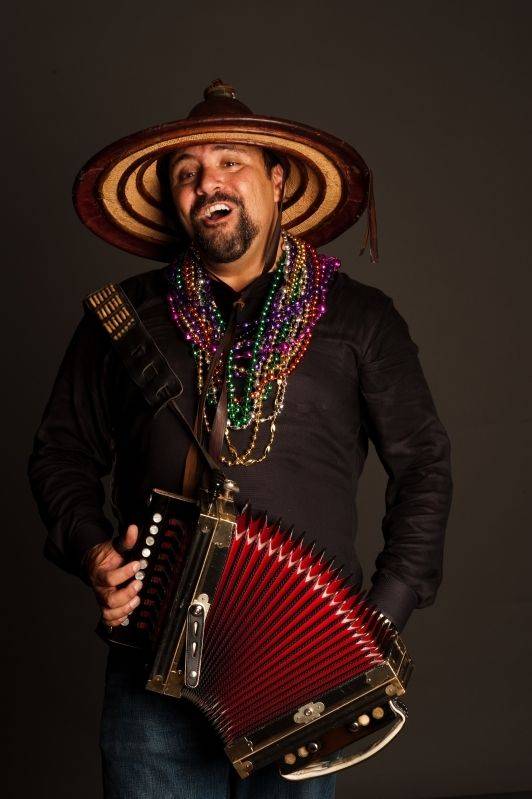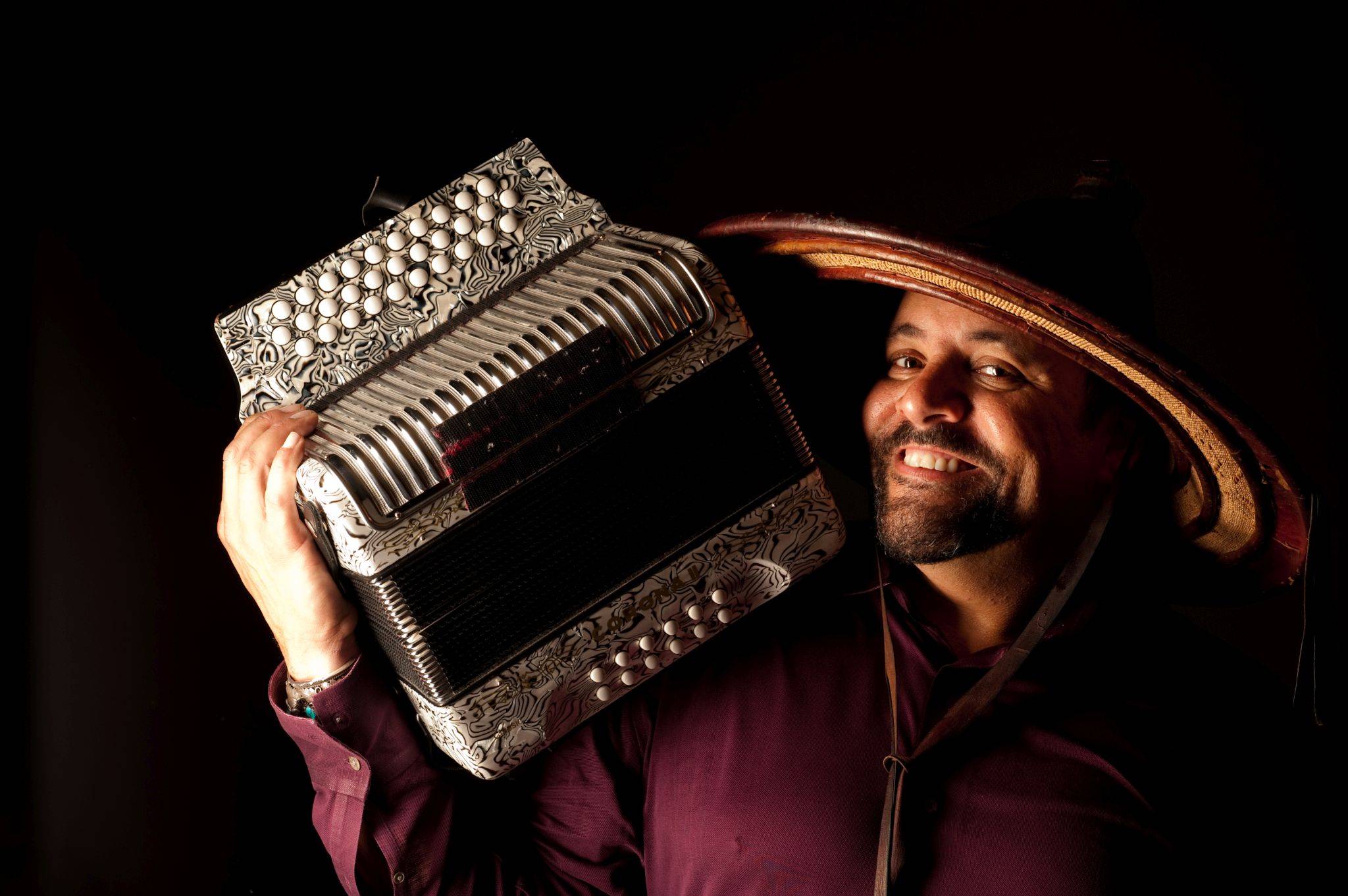“May I call you Terrance?”
“Of course, my brother.”
Those were my first words with Terrance Simien, the GRAMMY award-winning ambassador of Creole Zydeco music. He is as warm and inviting personally as the music he makes would suggest. Terrance Simien and the Zydeco Experience will be on stage this Friday night for the concert series Outside Research Park, sharing vibrancy with the collected community. Opening for Simien will be the inimitable Candy Foster and Shades of Blue. The show starts at 6:30 p.m. Pack a picnic basket and bring a chair. You won’t be sitting in it very much given the outstanding entertainment in store, but better safe than sorry.
The lead line at the top of his website seems to say it all: “Terrance Simien and the Zydeco Experience, 32 years, 7000 performances, 45 countries, Grammy award winning recordings,” but those facts hardly begin to tell the story of this genre-bending master of Zydeco music. Born in 1965, Simien is an eighth generation Creole from one of the earliest Creole families documented to have settled in the Mallet area of St. Landry Parish, northwest of Lafayette. He explained that Zydeco music is rooted in Creole music, that of the French speaking Creole people of south Louisiana. Much as the Blues took off in a different direction when it moved north, shedding the country sound and electrifying to appeal to a new urban audience, Creole music electrified became Zydeco.
Simien grew up listening to the music most accessible to him, Creole and Zydeco, of course, but also local radio. His mom was a fan of the popular music of the time — Sam Cook, The Beatles — and when learning to play the trumpet in school, he was exposed to classical, jazz, r&b and funk. He said his exposure to the Catholic Church choir began his love of singing. He acknowledged that many other Creole musicians who got their start in music from the Catholic Church.
Listening to Terrance Simien’s music, you hear the folk process taking shape, where the original form is transformed and re-adapted in the process of its transmission from person to person and from generation to generation. You hear the bounce of a two-step at the local fais do do, a Cajun dance party, the rhythm and syncopation of the Carribbean, or Africa, and the blues and old time themes of the upper delta and Appalachia. Add to that the inspired ballads of the folk music revival, and you begin to get the picture.
Terrance Simien’s influences are many and varied. They include John Delafose, also an accordion player, from Eunice, Louisiana, about 10 miles from Mallet, Simien’s hometown. Delafose led a very hot Zydeco band in the late 1970’s, but died young. Simien was also influenced by Clifton Chenier, a Zydeco pioneer, and the music of Amede’ Ardoin through his recordings, one of the first people to record the music of Arcadiana, a largly French speaking area of Louisiana settled by Acadians, or Cajuns. Chenier and Ardoin brought history and depth to Simien’s Creole influences. He had a brother who was into folk music and that put Terrance in touch with the music of Peter, Paul & Mary, Pete Seeger, Ritchie Havens, Bob Dylan and Paul Simon, among others. His sister loved funk music so he began listening to the Isley Brothers and Parliament-Funkadelic. On his own, he was discovering the music of Jimi Hendrix and others from the rock and roll charts. When talking about his influences he wanders back again to the church music, the hymns of his childhood. As he puts it, “We had some nuns that weren’t from Louisiana and they came with guitars and played these songs that sounded like folk songs, and that’s some of the first stuff I heard. All of that combined, that’s where I got a passion for music”.
When streaming through the Terrance Simien discography you can’t help but notice that he recorded many songs that would never be considered Creole, or Zydeco, until he recorded them. Listen to the Hedy West song, “500 Miles”, made popular by Peter, Paul & Mary, and then compare it to Simien’s version off of his album, “Positively Beadhead,” and you’ll hear the litany of influences that made their way through Simien’s life. The same can be said for the Dylan covers, “You Ain’t Goin’ Nowhere,” or “I Shall Be Released,” the Grateful Dead cover of “Franklin’s Tower,” and the Jimmy Cliff song, “Pressure Drop.” I asked Simien about the process of taking songs from other genres and remaking them in his own Zydeco style. “You know, Clifton Chenier did that before I did, and a few other people did it, too. It’s a matter of putting that Creole feel into the song”. But it’s more than just adding an accordion and a frottoir, a musical rub board, or washboard. “It’s having a passion for the song to begin with”. Simien added, “I do know that I’m not ever going to try to limit myself to say what this music is, or is not.” It’s important, he said, to go back to the roots of the music, starting with Jure rhythms of the African field hands. Jure is a polyrhythmic foundation for calls and prayers, and those rhythms are at the root of Creole music. Simien credits Alan Lomax with the genius and fortitude to travel to the most remote sections of the country and record, in the field, the music and rhythms of an earlier America. “If it would have stopped there, if the music didn’t evolve, I wouldn’t be here talkin’. It constantly evolves, and people add their own little flavor to the dish, a little seasoning,” he said. When asked about the impact Lomax’s work had on his music, he said, “It’s probably the most important thing to ever happen to American music”.
I asked Terrance about a writing credit I noticed on several songs, that of Greg Simien. “That’s my brother, my older brother and a Catholic priest. He was into folk music, and always a great singer, a better singer than I’ll ever be, and he still sings.” From songwriting, we moved onto the impact his music has on the people who experience it. I told him about two of my friends, who met attending a festival in Bridgeton, New Jersey, while dancing to his music, a two-step no doubt. They married a year later. I also mentioned a story I read about the man who drove 110 miles, took the day off work and everything, just to see his show. I asked Terrance if he hears these stories a lot. “It’s unbelievable. I can’t believe it, that we’re touching people like that. We’re just playin, we’re just having fun”. He spoke of music as medicine but insists, “we’re just out there playing — I’m just the messenger”, but acknowledges, “music does some amazing stuff. Without it, I don’t know what I’d be doing.” “Maybe a priest”, I offered. “The Simien Brothers, appearing at a parrish near you.”

Music has been good to Terrance Simien. When he first went overseas, at 21, he toured with Fats Domino and Sarah Vaughn and played the Montreux Jazz Festival, an auspicious beginning to a stellar musical career. “I was a kid, out of Mallet, out of nowhere, and got that opportunity. I’ll never forget that as long as I live”.








